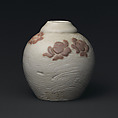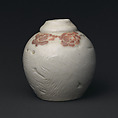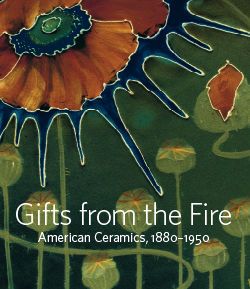Losanti vase
M. Louise McLaughlin American
Louise McLaughlin was a pioneering figure in the history of American ceramics. Like many women of her time, she began her artistic career as a china painter. One of her earliest innovations was her discover of the barbotine technique in the late 1870s and early 1880s. One of her most challenging endeavors was her decision to work in artistic porcelain, a medium that had traditionally been confined to a large factory setting. McLaughlin began her experiments in porcelain in 1898 in a studio in her home, which she called “Losanti;” although a small enterprise, she hired assistants to slip-cast models she created, and then she carved or excised designs into the vases, glazed them, and had them fired in a kiln in her back yard in Cincinnati. McLaughlin and her colleagues in Cincinnati were especially influenced by the work of contemporary Scandinavian potteries, notably the Royal Copenhagen Porcelain Manufactory and Bing and Grøndahl firm in Denmark and the Rørstrand in Sweden. This small vase has tiny pink blossoms strewn over the surface, encircled by meandering lines in a manner that recalls Japanese textiles.
Due to rights restrictions, this image cannot be enlarged, viewed at full screen, or downloaded.
This artwork is meant to be viewed from right to left. Scroll left to view more.




